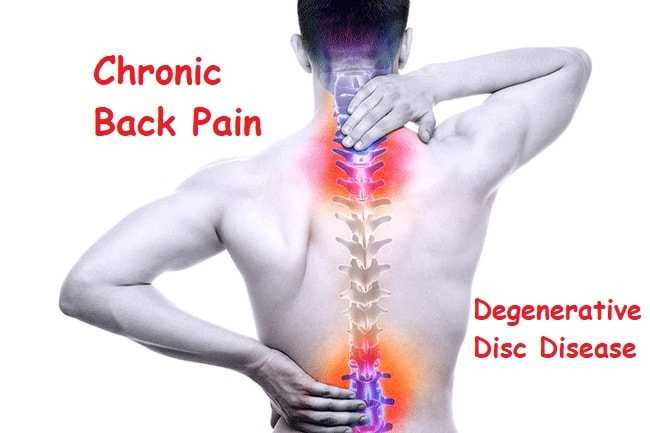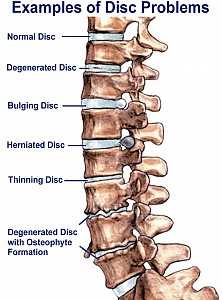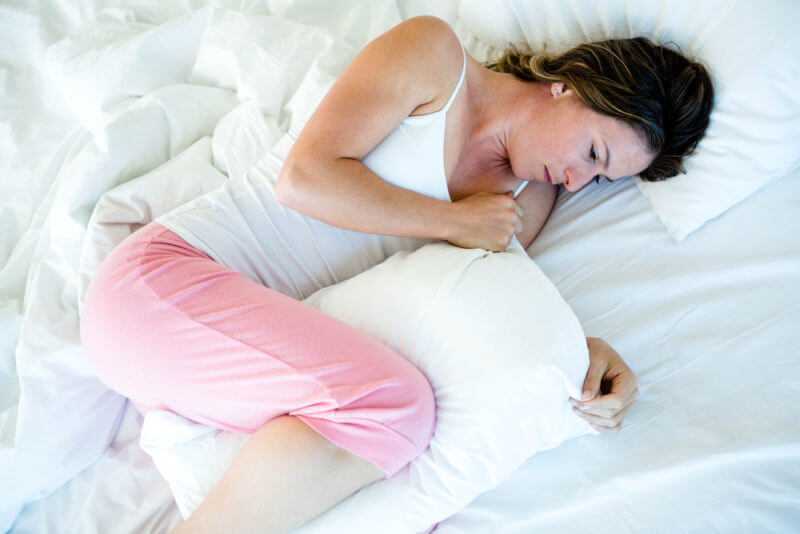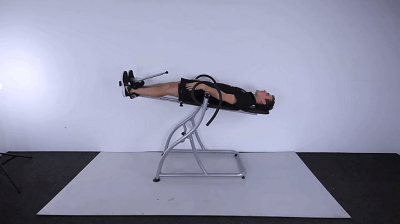Chronic Back Pain From Degenerative Disc Disease

The “padding” (called discs) between the bones of your spine (called vertebrae) wear out with aging. In that sense, everyone can expect to develop DDD…if they live long enough.
Just like a pillow eventually loses it’s fullness over time, so does every human being’s vertebral discs. Perhaps this is not as much “a disease” as it is the normal result of the “wear and tear” that a human body experiences through life?
There are certain people who have a tendency to develop this earlier in their life than expected. Sometimes you will see an entire family with “early” DDD.
There is also a greater chance to “wear out” earlier if you smoke, are overweight, have done very physical work during your life, or had experienced some unusual trauma (ie. you were a paratrooper).

Why Do You Get Pain?
There are several ways that chronic pain is generated from DDD. The disc is a structure that has a rim of tough cartilage on the outside (annulus fibrosus) with jelly in the center (nucleus pulposus). As the disc wears out it becomes flatter, the “jelly” drys out, and if it develops cracks in the rim cartilage it can “leak” the “jelly” from the center (called a herniated disc).
This all adds up to the neighboring structures becoming crowded, compressed, and forming boney overgrowth. Local nerves are compressed (click here to see my article on “What Is A Herniated Disc?”). the spinal canal can be narrowed, and the boney overgrowth causes facet joint deterioration (little joints on the top and bottom of most vertebrae). Chronic back pain can be generated by all these processes.


What You Can Do?
Yes…there are several recommendations to reduce the likelihood of developing DDD:
- Stop smoking.
- Stay lean.
- Avoid activities that put stress on your lower back.
- If you must work or perform activities that put stress on your back then consider back bracing during the activity.
- When exercising, develop your “core muscles” which will help distribute the stress to your lower back.
- Choose your parents well (just kidding).

Summary
Treatment should target the mechanism generating the pain. You will need an accurate diagnosis to start with. That will require a thorough history and physical, an MRI of the lumbar spine with contrast, and referral to a specialist that is familiar with DDD (ie. an Orthopedic Surgeon, Neurosurgeon, Pain Specialist, etc.). Your Primary Care Practitioner (PCP) should be able to coordinate this for you.
Under the best of circumstances, a team of people will be drawn together by your PCP. Practically speaking, your insurance company will place limitations on how extensive your team involvement is.
You will need to learn what works best to relieve your pain and develop your own treatment regimen. The people who do the best with chronic back pain from degenerative disc disease are those who “take charge” of their own therapy.
The combination of specific back exercises, weight loss, back bracing, lower back traction, and medications will usually result in the best outcomes. If you or a love one is suffering from chronic pain there is hope…
If you have questions please comment below. I would love to be of service to you.






Thanks for the article, it’s very useful. What kind of lower back traction would you recommend? Ex.inversion table? Also, in my case it seems like I get constant inflammation in my lower back. I really don’t want to be using anti inflammatory drugs all the time. Any advise? Thank you!
I suggest you take a look at this.
Disk Dr WG30 MAX Waist Discs Therapy Device Back Pain Treatment Support Belt
by Disk Dr
Link: http://a.co/d/344moT6